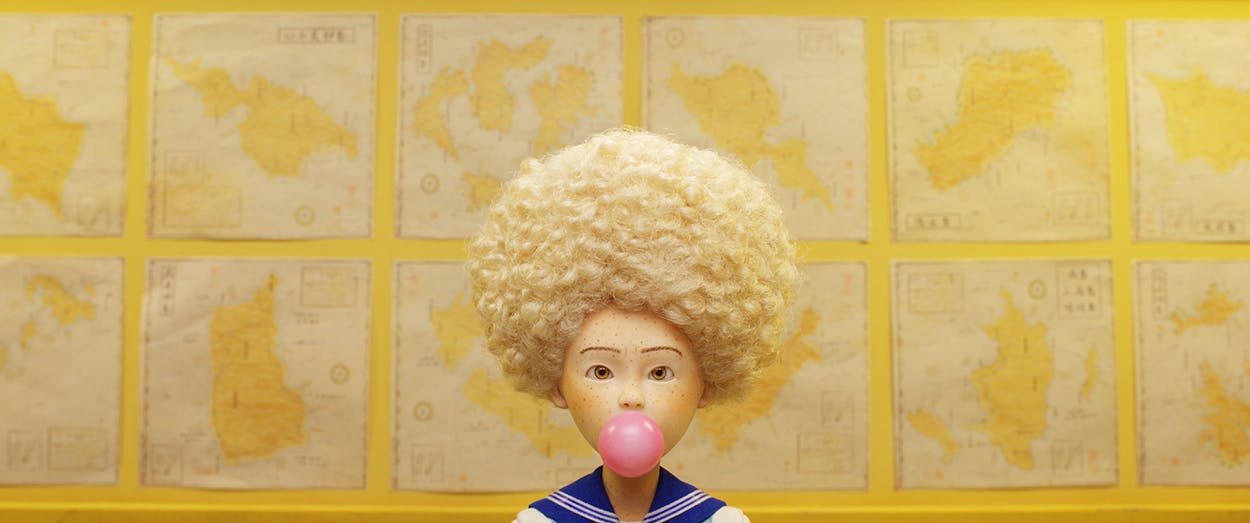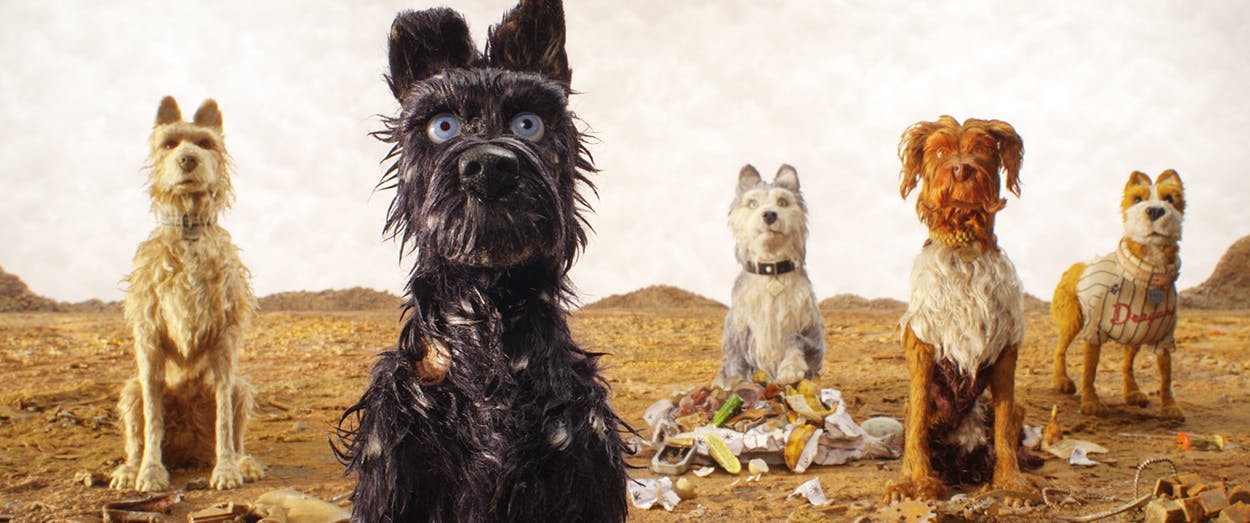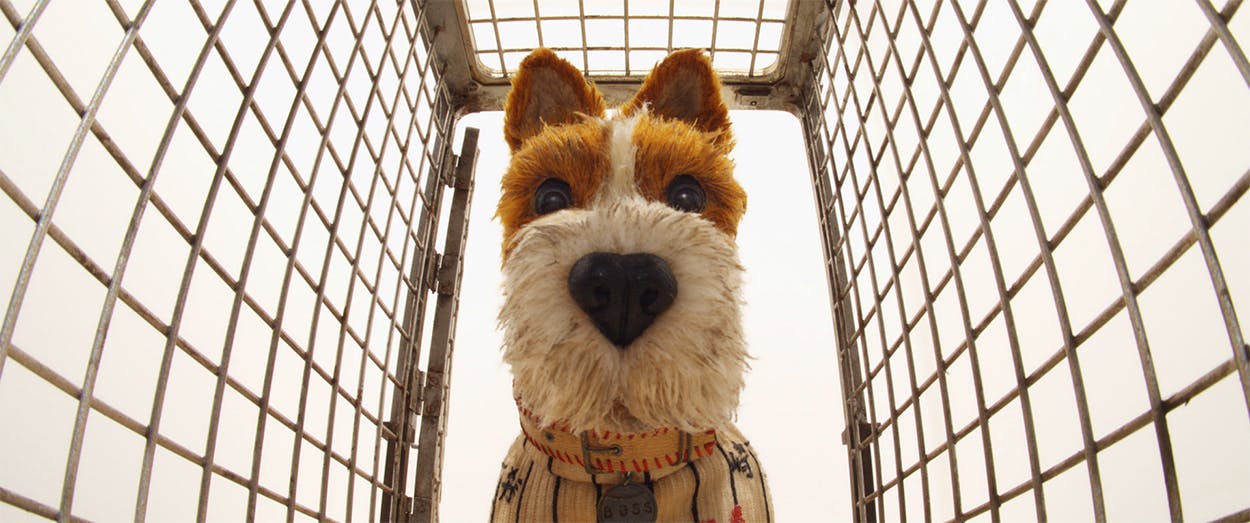Houston-born director Wes Anderson rolled out his second stop-motion feature with this month’s Isle of Dogs. The story takes place in the fictional Megasaki City, in Japan, and the bleak Trash Island, where all of the city’s canines have been banished by the corrupt Mayor Kobayashi. After the dogs have been sequestered indefinitely, the mayor’s ward, Atari, ventures to the island to find his beloved protector and companion, Spots. When Atari arrives on the island, he quickly falls in with a group of strays (voiced by Hollywood heavyweights Brian Cranston, Bill Murray, Edward Norton, Bob Balaban, and Jeff Goldblum) who help him on his quest to locate his pet.
Isle of Dogs encompasses many of the hallmarks of the nine other movies Anderson has directed—for better and for worse. We sent four of our writers to a screening of the film and asked them to discuss it.
Charley Locke: I am curious going in—are y’all Wes Anderson fans? What were your expectations?
Dan Solomon: I’m a fan of the movies Wes Anderson wrote with Owen Wilson. I’ve seen Bottle Rocket probably a hundred times, and Rushmore almost as many. (The Royal Tenenbaums, while amazing, doesn’t make me laugh the way those do, but it’s not meant to.) I have, uh, more complicated feelings about his mid-period and later movies. I liked Moonlight Kingdom, don’t mind Fantastic Mr. Fox, and hated The Darjeeling Limited. But I was looking forward to Isle of Dogs, because I like dogs, and I like animation, and I can be Charlie Brown to Wes Anderson’s Lucy-with-the-football when it comes to his work sometimes.
Emily McCullar: It’s fair to say that I’m a lifelong Anderson fan. I love Wes’s humor and aesthetic, when it works it really works. That being said, my expectations for Isle of Dogs were not that high. I knew it would be a work of art, at least from a technical perspective (stop motion seems so hard) but mostly I went in thinking, “I hope this isn’t too racist.” And frankly it wasn’t as racist as I thought it would be. Or maybe it was, and I was just distracted because it made my miss my dog so much. Dogs are such good boys and girls.
Doyin Oyeniyi: I’m a fan of Wes Anderson and I think I’ve seen a good majority of his films. The last one I watched was Fantastic Mr. Fox, his other stop-motion animated work, so that was on my mind when I saw the first trailer for this. That one had the same deadpan lines and quirky aesthetic as his other works with real humans and Isle of Dogs didn’t stray far from that. The thing that always catches me off-guard with Anderson films is that he always has a little bit of violence in them—they seem to come out of nowhere and both clash and work with the story he’s telling. This film seemed a bit gritty from the trailer—the dogs literally live on a trash island, but their appearance in general just seems unclean, if that makes sense—and so I shouldn’t have been as surprised as I was. I saw the movie with a friend who’s never seen a Wes Anderson film before and she commented that this might get relegated to as a kid’s movie because it’s animated and about dogs, but this is no kid’s movie.
I have to admit I didn’t think much about race in the beginning, but I’m curious about the decision to place this story in Japan. The country and the language played a bigger role in the story than I anticipated (there are entire moments of untranslated dialogue in Japanese), but I feel as if the story could have been told using another country with a similar result.

Dan: That’s something I’ve been thinking about a lot, Doyin, because it doesn’t have anything to say about Japan specifically. It creates its own Japanese myth to build its background on, it’s set in a fictional Japanese city, one of the only important human characters is an American exchange student, all the dogs are voiced by American actors…
Emily: I gather that the desire to set a movie in Japan was what fueled the movie from the start, and they built a story around that. I think the creators [Anderson, Jason Schwartzman and Roman Coppola] are just super into Japan.
Charley: My hope going into it was that being co-written by Kunichi Nomura, who voiced the mayor too, would help it move away from the kind of white-American-interlopers feel of Anderon’s Darjeeling Limited and Grand Budapest Hotel. I think the language conceit, where Japanese humans speak un-subtitled Japanese and dogs speak English, did end up working for me. And I was so nervous that the American exchange student (voiced by Greta Gerwig) would be the white savior! I was relieved it didn’t quite play out like that.
Doyin: I think it still played out like that.
Emily: It did play out like that. Also her hair.
Dan: Yeah, we should talk about that hair.

Doyin: Jesus, her hair.
Emily: It was essentially a blonde afro. And she was always raising her fist. Did not like.
Dan: Yeah, casting Greta Gerwig as Angela Davis was a weird-ass choice.
Emily: Though she’s kind of just a side-savior, not to give away too many spoilers. But she’s the only savior the non-Japanese-speaking audience can really understand.
Doyin: When we first see her, I initially thought she was a Japanese character who has permed her hair into an afro, which is a reality in some Asian countries. That made me uncomfortable enough and then realizing she was American didn’t make that any better.
Dan: Something Emily said that struck me, though, is that I did enjoy that even though I don’t speak Japanese, I did understand Atari, one of the main characters, and his motivations very clearly. It was fun to relate to that character because he loves his dog, and learns to love other dogs.
Doyin: That was one of the things that I thought was skillful about this. The decision to not translate 80 percent of the Japanese was very deliberate and I’m surprised by how much it worked for me. There was so much I felt I could understand without actually understanding, but I also can’t help but question it. At what point in the movie was that decision made? Who decided that? Who does that benefit? Viewers who understand Japanese are going to have a completely different movie experience than non-Japanese speakers, and what will that experience be? I’m really curious about the reception of this film in Japan.
Emily: Me too! I feel like so much of what works about the movie is that there is a language gap. Understanding without the help of a shared language is like one of the specialist parts of the bond between humans and their doggos.
Charley: I think that worked really well. Although it also made me feel very guilty for being a cat person.
Dan: Oh, Charley, now isn’t the time to admit that.
Doyin: Emily, you mentioned that the story fell flat in ways? What did you mean by that? I was personally anticipating more involvement from the cats or a better explanation for the hate of dogs, but we didn’t get one. Cats were present throughout the movie, but had no speaking roles. Ha. It’s like the conclusion is “cat people are evil.”
Emily: Yeah, the bad guy’s motivations never really made sense to me. I think that was spelled out in the prologue maybe, but then it got muddied for me. It just was never clear enough why they were banishing the dogs in the first place and the “conspiracy” never really clicked with me.
Dan: I felt like the villain’s motives were another sticking point where setting it in Japan was kind of an icky call. He hates dogs because his ancestors hated dogs, and had a generations-long mythology around hating dogs that involved being betrayed by a young samurai? That is a pretty weird thing to come up with. It sure seems to trade on some stereotypes, anyway.
Emily: Agree with you there. It just wasn’t fleshed out enough for me. I wish I understood more about Japanese culture to tell the difference between an homage and a lazy stereotyping but I feel somewhat out of my element here.
Dan: I’m wondering what the group of women I saw this movie with felt about the fact that, near as I can tell, all of the dogs were boys except for the sexy(?) show dog voiced by Scarlett Johansson and the breeding dog that appeared in the third act. That seems like a weird choice, since female dogs are very rarely feminized in real life the way they are in this movie.
Emily: I honestly did not even really noticed until you mentioned it, Dan. I think that has something to do with the fact that I also think of cats are girly and dogs as boys in the back of my head. That’s crazy, but I think there’s an old line from a SNL sketch about that.
Doyin: I feel like Anderson casts first and then writes characters later. Or maybe writes with specific actors in mind. Most of his frequent collaborators are guys. So.
Emily: You can add Wes Anderson to the list of filmmakers who don’t know what to do with Scarlett Johansson that doesn’t capitalize on her sex appeal.
Dan: Even when she’s literally playing a dog.
Charley: Why did all five dogs in the pack have to be male? I definitely did not like the fact that the female dogs were just love interests. Except for Tilda Swinton as Oracle, who was excellent!
Doyin: And I didn’t know she was a girl until she spoke because her character wasn’t sexualized. Oh, Wes has some work to do.
Emily: Wes Anderson’s movies are usually pretty boy-ish, and thus many of the female characters are created through the lens of how a fourteen-year-old would see a fourteen-year-old girl. That fourteen-year-old boy may be very unique and funny and sensitive, but he’s still a fourteen-year-old boy.
Charley: Can we talk a little bit about the world of the dogs? I thought that the conversations between the dogs about the particulars of their lives was a really great way for the Wes Anderson specificity to shine. I loved the way they talked about their homes, and how specific their quirks were—I love Jeff Goldblum, head gossip dog.

Emily: I think I had a dream afterwards about someone (a human I know) being the spokesperson for a dog food company, but it’s all kind of a blur. Clearly the dog world stayed with me.
Dan: The dog stuff was a lot of fun, and I really wish I were capable of watching a Wes Anderson movie with nothing but the joy I experienced watching a bunch of dogs voiced by actors I like talk about their favorite meals with such conviction. My favorite thing about the movie was that it made me want to come home and pet my dog and tell him what a good boy he is. It’s not a difficult button to push, but the movie definitely hit it.
Emily: He made me cry during the movie and after. I miss my best friend, Artie. Dogs are so great.
Doyin: Yeah, I’m not one to think too much about the interiority of dogs and I didn’t give them much thought after the movie, but I did like Chief as sort of the foil to “pets.”
Charley: I think the visuals of animated animals works so well for Anderson’s quirkiness, too. In the way that the badger had a three-piece suit in Fantastic Mr. Fox, I imagine there was so much specificity in what the dogs looked like.
Emily: Yeah, with movies like this it is so clear they had a lot of fun building and designing the universe. I love all the stuff with smoke and dust. It was like pulled apart cotton balls for smoke. Everything had a really fun texture to it.
Doyin: I always admire stop motion work, but I really liked the decision to incorporate 2-D animation into the film too. It gave the film an interesting feel.
Dan: Oh gosh, I loved that.
Emily: It was like a magical make-believe universe inside another magical make-believe universe. Again, I kinda wish I was ten years old right now so this could be my new favorite movie.
Dan: It was so neat to see all of the characters through a few different lenses within the same movie. Stuff like that is why I keep coming back to this dude’s movies even when I end up spending most of the post-film conversation grousing about the racism, sexism, plot-dumbness, etc. that distracted me from the fun stuff. Because there is real cinematic joy in watching him work sometimes.
Doyin: It’s really interesting to watch creators like Wes Anderson work and how they get to develop their signature styles and explore their creativity while not necessarily always telling the best stories. I admire that, but I can’t help but think about directors of color or women who don’t get the same opportunities. I can enjoy the work, like I did this movie, but I always have questions.
Charley: Yeah, I agree with that.
Emily: Fair point, the industry definitely extends more opportunities to auteurs of Anderson’s ilk.
Emily: Should we talk about the music? It was less of a soundtrack that most Wes Anderson movies. I think I only heard the one song a couple of times.
Doyin: I can’t comment because I don’t remember the music at all. It didn’t make that much of an impact on me.
Charley: I thought West Coast Pop Art Experimental Band’s “I Won’t Hurt You” coming back multiple times was great. I liked the repetition of a song coming back as kind of their adventure soundtrack.
Emily: We get it, Charley! You’re from California!
Charley: ABBY LIKED IT TOO. [Editor’s note: I did! —Abby Johnston]
Emily: That song definitely made me cry. The “I won’t hurt you” refrain reminded me of my sweet, dead dog, Artie. He was a big boy (100 pounds at one point) and could’ve easily torn me to bits had he been so inclined. But he only ever wanted to protect us, and bring back the stick he thought we’d lost. Dogs and humans have such a lovely bond. Like Dan said, it’s a pretty easy button to push, but dang if Wes didn’t push it hard.
Doyin: What stood out to me were the small comedic moments in the film. Like the moment when the dogs start talking when Atari unlocks the cage, or the chocolate milk scene at the bar. I found those all really delightful and I think there’s something about stop motion that makes those moments even funnier than if it were real people acting them out.

Charley: Yeah, I loved the specifics of the bossy chocolate milk order. Also I did not realize until after the movie that Yoko Ono, the scientist, was played by Yoko Ono. I cringed at that at first.
Doyin: I cringed too and did not realized until I looked on IMDB later.
Emily: Hopefully we can spare our readers from similar cringes.
Doyin: So what’s our final take on this movie? Did y’all like it?
Emily: I did. It wasn’t the best movie I’ve ever seen, but I enjoyed it and am overall impressed by the work that went into it and the product created. It would be great to watch with or as a pre-teen. It’s also probably really fun to watch on a plane.
Dan: I liked things about it, but I think it’s mostly a bad movie. It doesn’t really tell a coherent story, it isn’t internally consistent, and it has a whole bunch of problems that distracted me to the point that I couldn’t ever really lose myself in it. It’s fun to watch Anderson work as a visual stylist, and there are things he does well that are on display here, but I thought the movie was mostly a mess. Maybe it’s time for me to end my complicated relationship with Wes Anderson altogether so I don’t drag down his Rotten Tomatoes ratings unfairly, but I just didn’t connect with Isle of Dogs.
Charley: I liked it, with reservations. I think the stop-motion and animation was such a good forum for the quirky specifics of Anderson, which feel more twee to me when they’re actors. There are some lasting problems, for sure, but I had a fun time watching it—like Emily, I think it’d be a good plane movie, or to watch and enjoy with a younger audience.
Doyin: I did enjoy it, but it’s complicated. It gave me appreciation for Anderson’s creativity and the art people can make with stop motion and animation, but I have so many questions about the Japanese backdrop of this story and not all the creative decisions worked for me. It’s funny that I never thought about what would make a good “plane movie” before Emily said so, but this fits that description pretty well. Something to watch to kill the time and that will get a few laughs out of me, but not something to think about too deeply.
Emily: The plane movie is a very important category.
- More About:
- Film & TV









